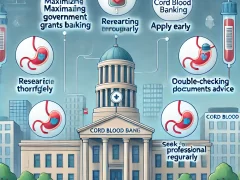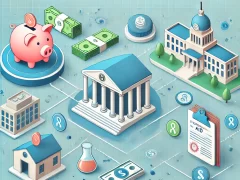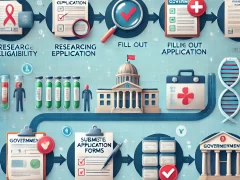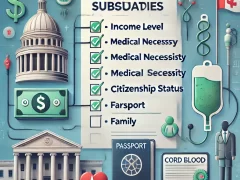
Understanding Government Grants and Subsidies for Cord Blood Banking
Cord blood banking has become an increasingly important aspect of modern healthcare, offering a valuable source of stem cells for medical treatments and research. However, the costs associated with establishing and maintaining a cord blood bank can be a significant barrier for many healthcare providers and families. Fortunately, government grants and subsidies can help alleviate these financial burdens, making cord blood banking more accessible.
Unlocking the Potential of Government Support
Governments around the world have recognized the importance of cord blood banking and have implemented various programs to support its growth. These initiatives can take the form of direct grants, tax incentives, or subsidies that help offset the costs associated with establishing and maintaining a cord blood bank.
Exploring Federal Grant Opportunities
In the United States, the federal government has established several grant programs that provide funding for cord blood banking initiatives. The National Cord Blood Inventory (NCBI) program, for example, offers grants to public cord blood banks to help expand their collections and increase the diversity of the national inventory. Similarly, the Health Resources and Services Administration (HRSA) administers the Stem Cell Therapeutic Outcomes Database (SCTOD) program, which provides funding for the collection, storage, and distribution of cord blood units.
Tapping into State-Level Subsidies
In addition to federal grants, many state governments also offer their own incentives and subsidies for cord blood banking. These programs may include tax credits or deductions for families who choose to store their child’s cord blood, or direct subsidies to cord blood banks to support their operations. By leveraging these state-level initiatives, healthcare providers and families can significantly reduce the financial burden associated with cord blood banking.
Understanding the Application Process
Accessing government grants and subsidies for cord blood banking often requires navigating a complex application process. Prospective applicants may need to provide detailed information about their operations, financial statements, and plans for using the funds. It’s essential to carefully review the eligibility requirements and submission deadlines to ensure a successful application.
Maximizing the Impact of Government Support
Once obtained, government grants and subsidies can be used to support a wide range of cord blood banking activities. This may include upgrading storage facilities, expanding collection efforts, or investing in research and development. By strategically leveraging these funds, cord blood banks can enhance their capabilities, improve patient outcomes, and contribute to the advancement of regenerative medicine.
Staying Informed and Adaptable
The landscape of government grants and subsidies for cord blood banking is constantly evolving, with new programs and funding opportunities emerging regularly. Cord blood banks and healthcare providers must stay informed about the latest developments and be prepared to adapt their strategies to take advantage of these changing circumstances.
By understanding and effectively utilizing the available government support for cord blood banking, healthcare providers and families can overcome the financial barriers and unlock the full potential of this transformative technology. As the demand for cord blood-derived therapies continues to grow, the role of government grants and subsidies will become increasingly crucial in shaping the future of this vital field.
Unveiling the Regulatory Landscape of Cord Blood Banking
Cord blood banking has emerged as a crucial aspect of modern healthcare, offering families the opportunity to preserve a valuable biological resource for potential future medical applications. However, navigating the complexities of the regulatory environment surrounding this field can be a daunting task. In this article, we’ll delve into the intricacies of government grants and subsidies available for cord blood banking, providing you with the knowledge and insights to make informed decisions.
Understanding the Regulatory Framework
Cord blood banking is a highly regulated industry, with varying standards and requirements across different regions and jurisdictions. At the heart of this regulatory landscape are government agencies tasked with ensuring the safety, quality, and ethical practices of cord blood banking operations. Understanding the specific regulations and guidelines in your local area is crucial for navigating the process effectively.
Exploring Government Grants and Subsidies
One of the key factors to consider when exploring cord blood banking is the availability of government grants and subsidies. These financial incentives can help offset the costs associated with the collection, processing, and storage of cord blood, making it more accessible to families from diverse backgrounds.
Identifying Eligible Programs
Governments around the world have implemented various programs to support and promote cord blood banking. These initiatives can range from tax credits and rebates to direct funding for cord blood collection and storage. Researching the specific programs available in your region is the first step in determining your eligibility and accessing these valuable resources.
Applying for government grants and subsidies related to cord blood banking can be a complex process, often requiring detailed documentation and adherence to specific guidelines. Understanding the application requirements, deadlines, and the necessary paperwork can help ensure a smooth and successful submission.
Maximizing the Benefits of Cord Blood Banking
By taking advantage of government grants and subsidies, families can not only alleviate the financial burden of cord blood banking but also increase access to this potentially life-saving resource. This, in turn, can lead to greater participation in cord blood donation programs, ultimately benefiting the broader healthcare ecosystem.
Staying Informed and Up-to-Date
The regulatory landscape of cord blood banking is constantly evolving, with new policies, programs, and guidelines being introduced on a regular basis. Staying informed and up-to-date on the latest developments is crucial for families and healthcare providers alike. Engaging with industry organizations, regulatory bodies, and trusted informational resources can help ensure that you remain at the forefront of the ever-changing cord blood banking landscape.
Navigating the complexities of cord blood banking regulations can be a daunting task, but understanding the available government grants and subsidies can make the process more accessible and affordable for families. By staying informed, exploring eligible programs, and navigating the application process, you can unlock the potential of cord blood banking and contribute to the advancement of personalized healthcare.
Maximizing Financial Incentives for Cord Blood Donations
Exploring Government Grants and Subsidies for Cord Blood Banking
Cord blood banking has become an increasingly important practice in recent years, providing a valuable source of stem cells for medical treatments. However, the costs associated with cord blood banking can be a significant barrier for many families. Fortunately, various government grants and subsidies are available to help offset these expenses and make cord blood banking more accessible.
Understanding the Benefits of Cord Blood Banking
Cord blood is the blood that remains in the umbilical cord and placenta after a baby is born. This blood is rich in stem cells, which have the potential to be used in the treatment of a wide range of medical conditions, including leukemia, lymphoma, and certain genetic disorders. By banking their child’s cord blood, parents can ensure that these valuable stem cells are available for potential future use.
Accessing Government Assistance for Cord Blood Banking
Recognizing the importance of cord blood banking, many governments have implemented programs to provide financial support to families. These programs can take the form of grants, subsidies, or tax credits, and they are designed to help offset the costs of cord blood collection, processing, and storage.
Grants and Subsidies for Cord Blood Banking
In the United States, for example, the Newborn Screening Saves Lives Reauthorization Act of 2014 established the Cord Blood Stem Cell Program, which provides grants to support the collection and storage of cord blood units. These grants are available to both public and private cord blood banks, as well as to healthcare providers who offer cord blood banking services.
Similarly, in Canada, the federal government has introduced the Cord Blood Bank Contribution Program, which provides funding to support the establishment and maintenance of a national cord blood bank. This program is designed to ensure that a diverse and high-quality supply of cord blood units is available for transplantation and research purposes.
Tax Credits and Deductions
In addition to grants and subsidies, some governments also offer tax-based incentives for families who choose to bank their child’s cord blood. For instance, in the United Kingdom, the Seed Enterprise Investment Scheme (SEIS) provides tax relief for individuals who invest in qualifying cord blood banking companies.
In Australia, the government offers a tax deduction for the costs associated with storing cord blood and cord tissue. This deduction can be claimed as a medical expense, helping to offset the financial burden of cord blood banking.
To take advantage of government assistance for cord blood banking, families will typically need to follow a specific application process. This may involve submitting documentation, such as medical records or proof of income, and meeting certain eligibility criteria.
It is important to research the available programs in your local area and understand the requirements and application deadlines. Many government websites and cord blood banking providers can offer guidance and support throughout the application process.
Cord blood banking can provide significant medical benefits, but the associated costs can be a barrier for many families. Fortunately, government grants, subsidies, and tax incentives are available to help make this important practice more accessible. By understanding and taking advantage of these financial support mechanisms, families can ensure that their child’s cord blood is safely stored and available for potential future use.
The Evolving Landscape of Cord Blood Banking Policies
The Shifting Dynamics of Cord Blood Banking Policies
The world of cord blood banking has undergone significant transformations in recent years, driven by evolving policies, technological advancements, and shifting societal priorities. Understanding these changes is crucial for individuals and families considering cord blood banking, as it can impact the availability, accessibility, and utilization of this valuable resource.
The regulatory framework surrounding cord blood banking has become increasingly intricate, with various government agencies and healthcare organizations playing a role in shaping the policies. In many countries, regulatory bodies have implemented guidelines and standards to ensure the safety, quality, and ethical practices of cord blood banking. These policies often address issues such as donor consent, storage requirements, and the use of cord blood for therapeutic purposes.
Public vs. Private Cord Blood Banking: Weighing the Options
The choice between public and private cord blood banking has long been a topic of debate. Public cord blood banks collect and store donations from the general population, making them available for those in need. Private banks, on the other hand, store cord blood solely for the use of the individual or family who banked it. As governments and healthcare systems grapple with the costs and benefits of each approach, families must carefully consider their priorities and the potential future needs of their child.
Subsidies and Financial Assistance: Improving Accessibility
In recognition of the importance of cord blood banking, some governments have introduced financial incentives and subsidies to increase accessibility and participation. These initiatives can take various forms, such as tax credits, grants, or direct funding for cord blood collection and storage. By reducing the financial burden on families, these programs aim to make cord blood banking a viable option for a broader segment of the population.
Emerging Technologies and Innovations
The field of cord blood banking has also witnessed a surge of technological advancements and innovations. Improved cryogenic storage techniques, enhanced processing methods, and the development of advanced therapeutic applications have all contributed to the evolving landscape. These innovations not only improve the quality and longevity of stored cord blood but also open up new avenues for its clinical use, such as regenerative medicine and personalized therapies.
Ethical Considerations and Evolving Societal Perspectives
As cord blood banking becomes more prevalent, discussions around ethical concerns have also intensified. Issues such as informed consent, the rights of donors, and the equitable distribution of this precious resource have sparked debates among policymakers, healthcare professionals, and the general public. These dialogues have, in turn, influenced the development of policies and guidelines to ensure the ethical and responsible management of cord blood banking.
Collaborative Efforts and Global Coordination
In response to the complex and evolving nature of cord blood banking, there has been a growing emphasis on collaborative efforts and global coordination. International organizations, such as the World Marrow Donor Association and the International Society for Cellular Therapy, have established guidelines and standards to facilitate the exchange of best practices and promote harmonization across different regions.
As the landscape of cord blood banking continues to transform, individuals and families must stay informed about the latest developments, policies, and opportunities to make well-informed decisions that align with their personal values and healthcare needs. By understanding the nuances of this dynamic field, they can navigate the options and ensure that their cord blood banking experience is both meaningful and beneficial.
Strategies for Securing Funding for Cord Blood Banking Initiatives
Unlocking Funding Opportunities for Cord Blood Banking Projects
Navigating the realm of government grants and subsidies can be a daunting task for those seeking to establish or expand cord blood banking initiatives. However, with the right strategies and a deep understanding of the available funding sources, it is possible to secure the necessary resources to bring your vision to life.
Identifying Relevant Government Funding Programs
The first step in securing funding for your cord blood banking project is to identify the appropriate government agencies and programs that offer financial support. These can vary from country to country, so it’s crucial to research the funding landscape in your specific region.
In the United States, for example, the National Institutes of Health (NIH) and the Department of Health and Human Services (HHS) are two key sources of funding for cord blood banking research and development. Programs such as the Small Business Innovation Research (SBIR) and the Small Business Technology Transfer (STTR) grants can provide valuable financial assistance to eligible organizations.
Leveraging Partnerships and Collaborations
Forming strategic partnerships and collaborations can significantly increase your chances of securing government grants and subsidies. By aligning your project with established institutions or research centers, you can tap into their existing networks and expertise, making your proposal more attractive to funding agencies.
Consider reaching out to academic institutions, medical centers, or industry leaders in the cord blood banking field to explore potential collaborations. These partnerships can help strengthen your application, provide access to specialized resources, and demonstrate the viability and impact of your initiative.
Crafting a Compelling Grant Proposal
The grant proposal is the cornerstone of your funding application, and it’s essential to ensure that it is well-crafted and persuasive. Begin by thoroughly understanding the funding agency’s priorities, guidelines, and requirements. This will help you tailor your proposal to address their specific needs and concerns.
Emphasize the innovative nature of your cord blood banking project, its potential for scientific and clinical advancements, and the positive impact it can have on public health. Clearly articulate your project’s goals, methodology, and expected outcomes, and provide a detailed budget that aligns with the funding agency’s guidelines.
Leveraging Existing Cord Blood Banking Initiatives
If your cord blood banking project is connected to or builds upon existing initiatives, be sure to highlight this in your grant proposal. Demonstrate how your project can leverage the successes and lessons learned from previous efforts, further enhancing the chances of securing government funding.
Many countries have established national or regional cord blood banking programs, and aligning your project with these initiatives can make your proposal more compelling. Explore opportunities to collaborate with these established programs, share resources, and contribute to the broader goals of advancing cord blood banking research and access.
The grant application process can be complex and time-consuming, but understanding the steps and requirements can significantly improve your chances of success. Be prepared to devote substantial time and resources to preparing a thorough and well-documented application.
Stay informed about deadlines, submission guidelines, and any required materials or documentation. Carefully review the application instructions and seek clarification from the funding agency if any aspects are unclear. Additionally, consider seeking assistance from experienced grant writers or consultants who can provide valuable guidance and support throughout the process.
By leveraging these strategies, cord blood banking organizations can unlock a wealth of government funding opportunities and propel their initiatives forward, contributing to the advancement of this critical field of medicine.
Conclusion
The world of cord blood banking is a constantly evolving landscape, with government grants and subsidies playing a crucial role in shaping its future. As we’ve explored, understanding the complexities of regulations, maximizing financial incentives, and navigating the changing policies are all essential components for those seeking to establish or maintain successful cord blood banking initiatives.
One of the key takeaways from our discussion is the importance of staying informed and adaptable when it comes to government funding opportunities. The regulatory environment surrounding cord blood banking can be intricate, with varying laws and guidelines across different regions. By staying up-to-date on the latest developments and proactively engaging with regulatory bodies, organizations can ensure they are positioned to take advantage of available grants and subsidies.
Furthermore, the ability to effectively communicate the value and impact of cord blood banking can be a decisive factor in securing funding. Cord blood donations have the potential to save lives, and by highlighting the tangible benefits to both public health and the scientific community, organizations can make a compelling case for government support. Leveraging data-driven strategies, building strategic partnerships, and demonstrating measurable outcomes can all contribute to successful funding applications.
Another crucial consideration is the evolving landscape of cord blood banking policies. As scientific advancements and societal priorities shift, the landscape of government funding and regulatory frameworks is also in flux. Cord blood banking organizations must be prepared to adapt their strategies and approaches to remain competitive and continue to receive the necessary support.
Strategies for securing funding can take many forms, from traditional grant applications to innovative public-private partnerships. Cord blood banking organizations should explore a diverse range of funding sources, including federal, state, and local government programs, as well as private sector initiatives and philanthropic contributions. By diversifying their funding streams, these organizations can reduce their reliance on a single source and ensure the long-term sustainability of their operations.
The successful navigation of the government grants and subsidies landscape is crucial for the future of cord blood banking. By understanding the complexities of regulations, maximizing financial incentives, and staying agile in the face of policy changes, organizations can position themselves to access the necessary resources to continue their vital work. As we move forward, the continued collaboration between the public and private sectors, as well as the unwavering commitment to advancing the field of cord blood banking, will be instrumental in shaping a future where more lives can be saved through this remarkable medical innovation.



















